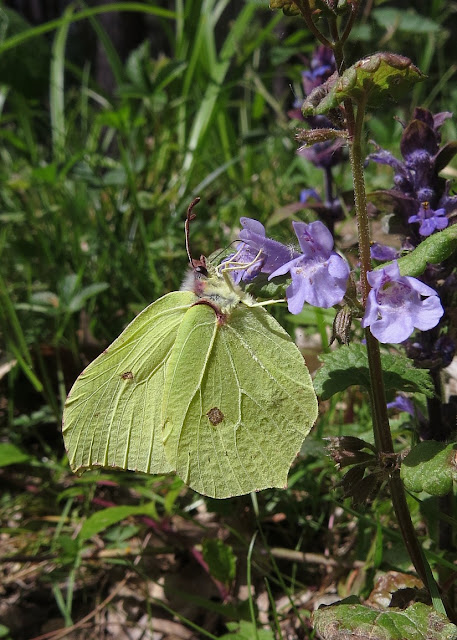These Sticky Catchfly flowers were unusual in having a white calyx
not the usual concolorous ones. Here being admired by Rhys who'd never seen them in this colour form before.
These were the only ones (which after a bit of a climb) were easy to approach.
Most were up this slope which the warden had recently cleared of brambles. It wasn't too difficult to climb up there but the problem was that the whole slope was one big Wood Ant nest. I passed on getting a close up shot and used the zoom from here instead.
Sticky Catchfly - Silene viscaria
Upright Clover is a very rare clover only growing here at Stanner Rocks and on The Lizard in Cornwall.
Upright Clover - Trifolium stictum
Even rarer is this lovely little plant, Upright Perennial Knawel. A subspecies of Perennial Knawel which only grows at this one site in Britain.
Upright Perennial Knawel - Scleranthus perennis ssp.perennis
Stanner Rocks is certainly an amazing site with these plants as well as the equally rare Early Star of Bethlehem, which flowers here in the late winter and many rare mosses too. Please note that only the Quarry Floor is open to the public and access to the rest of the reserve is by means of a guide. So many thanks to Natural Resources Wales and Rhys for showing us these great wildflowers.
Next stop was on the banks of the River Wye near Boughrood where we saw the rare and beautiful Rock Cinquefoil and also Chives.
Rock Cinquefoil - Potentilla rupestris
Chives - Allium schoenoprasum
Our time admiring these lovely flowers was cut short by some hefty rain showers and so we set of for our next destination which was a long drive away, right through the heart of Wales to Anglesey on the northwest coast. We arrived at Holyhead in the evening and hoped for fine weather the next morning because for the flower we wanted to see this is a prerequisite. Spotted Rock-rose is the county flower of Anglesey and its delicate yellow flowers only open in fine weather and even then the petals may fall before midday! You need to time it right to see this one! Fortunately the next morning was bright if not sunny so we set off to Porth Diana with high hopes. Happily they were in flower and really were a sight to behold, simply exquisite!
Some like this one have smaller brown spots and some..
Just weren't conforming at all!
Spotted Rock-rose - Tuberaria
guttata
The field at Porth Diana where they grow has a lovely array of other wildflowers, including drifts of Heath Spotted-orchids and Spring Squill.
Heath Spotted-orchid - Dactylorhiza maculata
This Heath Spotted-orchid is probably the most flouncy, frilly one I've ever seen.
Tall Ramping Fumitory - Fumaria bastardii
This was a nice surprise, spotted growing at the side of the road whilst walking back to the car.
The bright salmon pink colour really stood out but I still had to get the books out to confirm the ID.
Notice the colour coordinated aphid on the stem.
Next stop was South Stack where I was hoping to see Spathulate Fleawort or South Stack Fleawort as it is endemic to Holyhead Island, around South Stack, growing on steep cliffs. There weren't that many plants in flower at the time of our visit and they were quite a way down the cliff-side. I was determined to get some nice photos so had to lie on the ground and lean over the edge. I think it was worth the abject terror! ;-)
You can get some idea of the steepness in this photo
although it doesn't look as steep as it actually was.
Spathulate Fleawort - Tephroseris integrifolia subsp. maritima
And here with an Ant and a carpet of Spring Squill.
A bonus find here growing among rocks on the steps and surrounding heathland was Heath Pearlwort, a new species for both of us. Although it isn't rare we had somehow managed to avoid seeing any on our travels. It was pretty difficult to get photos of the flowers in the bright sun, with them being so small and brilliant white. We collected quite a few spectators wondering why we were photographing the ground!
Heath Pearlwort - Sagina subulata
A view from South Stack over Anglesey with Snowdonia in the distance
I was really hoping to get some good views of Coughs and did see a couple but they were a bit distant for good photos and back lit too. Didn't stop me trying though.
Finally we made our way over to The Great Orme where it was exceedingly windy as opposed to the usual windy! We managed to see most of our target species there. The notable exception being Spotted Cat's-ear which we can't seem to find anywhere!
Hoary Rock-rose.
Most of the flowers were closed due to the wind strength. This one was in a slightly more sheltered spot but you can see that it was very windy by looking at the anthers. We found a lot more on the west cliffs in a much more sheltered location which were flowering well.
Hoary Rock-rose - Helianthemum oelandicum ssp incanum
Welsh Hawkweed - Hieracium
cambricum
A rare endemic which only grows on The Great Orme.
Wild Cotoneaster is endemic to the Great Orme. It is also
the only species of Cotoneaster native to the British Isles. It has
never been found naturally at any other location.
It is also sometimes called The Great Orme Berry
Wild Cotoneaster - Cotoneaster cambricus
























































































